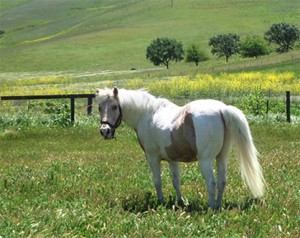Equine Vets Treat Complicated Infectious Disease Case- Equine Coronavirus
UC Davis News
VMTH “Case of the Month” – May 2014
Apache, a 21-year-old gelding, was not enjoying his most recent visit to the farrier for a hoof trimming. That was the first sign to his owner that something was wrong.
“Apache generally never behaves badly in these situations,” said his owner Kellie. “I was very surprised when the farrier told me he was kicking at his belly.”
His signs progressed throughout the day. Apache immediately laid down upon exiting the trailer after the farrier visit, and had diarrhea and a fast heart rate. He also seemed colicky and hadn’t been eating much recently. Apache’s veterinarian thought the best course of action was to get him to the UC Davis Veterinary Medical Teaching Hospital right away.
Once at the VMTH, Drs. Monica Aleman, Krista Estell and Elsbeth Swain, with the Equine Medicine Service, quickly took notice of his symptoms – anorexia, lethargy, fever, diarrhea, colic. All of these are common signs of equine coronavirus (ECoV) infection, a recently discovered contagious disease that has been on the rise in adult horses.
To test for ECoV, the veterinarians examined Apache’s feces by performing what is commonly referred to as a PCR test, which amplifies the viral DNA in the feces to allow identification of the virus. Apache’s distended abdomen indicated another health issue as well, so as part of the diagnostic work-up, veterinarians performed a belly tap to collect a sample of the fluid that bathes the intestine. The fluid was abnormally orange and opaque, and a laboratory examination of it revealed Apache had Actinobacillus peritonitis, a bacterial infection causing inflammation of the abdominal lining.
The combination of ECoV and peritonitis was going to pose a substantial challenge for the veterinarians. While ECoV does not have a high mortality rate, Apache’s case could turn fatal due to its complexity. To make matters worse, Apache had developed gastric reflux, necessitating placement of a nasogastric tube to relieve distension of his stomach by releasing fluid pressure build-up as the intestinal contents flow the wrong direction due to the severe inflammation of his gastrointestinal tract.
Because ECoV is highly contagious, Apache was immediately quarantined to the VMTH’s isolation unit, a separate facility on the hospital grounds far removed from the hospital and barns. Treatment was initiated, and included IV fluids and anti-inflammatories to treat the ECoV, and antibiotics to treat the peritonitis.
Apache’s gastric reflux required the tube be left in place for several days, and required him to be held off feed until the reflux was in check. After four days, the reflux started to resolve and Apache finally started defecating again. His fever also broke around this time. It appeared he was on the road to recovery.
Apache eventually went home after eight days in the isolation unit. Kellie kept him isolated and on anti-inflammatories and antibiotics for several days. She switched Apache to an alfalfa diet to encourage him to eat during his recovery, and he markedly improved after five days at home. After about two more weeks of recovery, Apache was back to his old self teaching children how to ride.











